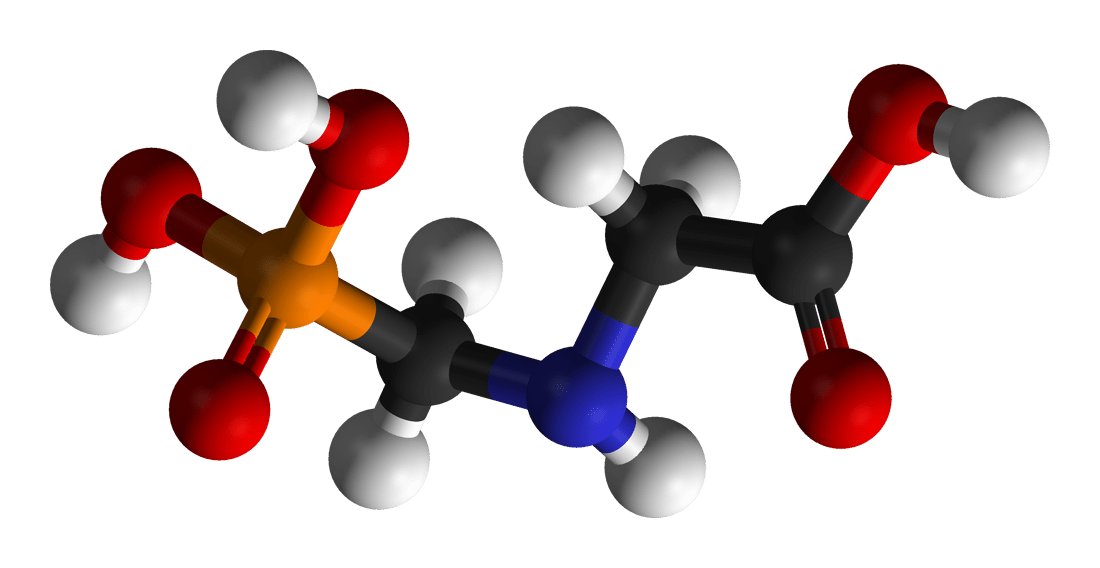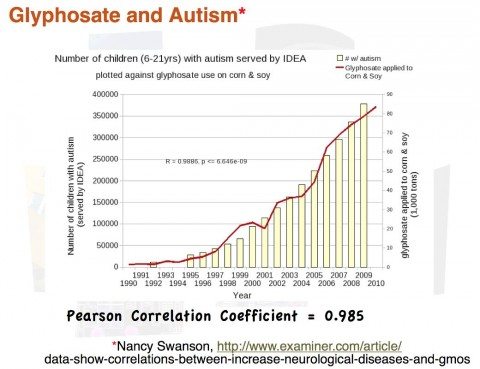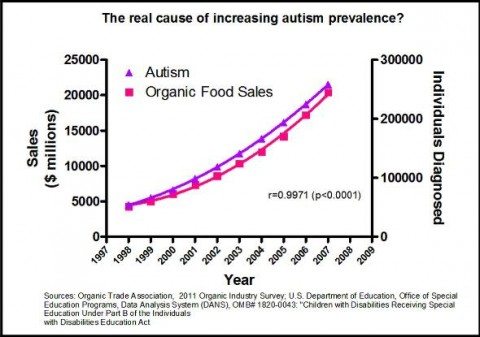
3D model of the molecular structure of glyphosate.
There is an ideological subculture that is motivated to blame all the perceived ills of the world on environmental factors and corporate/government malfeasance. Often this serves a deeper ideological drive, which can be anti-vaccine, extreme environmentalism, or anti-GMO. The latest environmental bogeyman making the rounds is glyphosate, which is being blamed for (you guessed it) autism.
Glyphosate is the active ingredient in the herbicide Roundup. It has been widely used for about 40 years, and with the introduction of GM crops that are Roundup resistant, its use has increased significantly in the last 20 years. It has therefore become a popular target for anti-GMO fearmongering.
Glyphosate is one of the least toxic herbicides used. It inhibits the enzyme 5-enolpyruvylshikimic acid-3-phosphate synthase which interferes with the shikimic pathway in plants, resulting in the accumulation of shikimic acid in plant tissues and ultimately plant death. The enzyme and pathway do not exist in animals, which is why toxicity is so low. Still, chemicals can have multiple effects and so toxicity needs to be directly measured and its epidemiology studied.
A systematic review published on 2000 found:
Experimental evidence has shown that neither glyphosate nor AMPA bioaccumulates in any animal tissue. No significant toxicity occurred in acute, subchronic, and chronic studies.
and
Therefore, it is concluded that the use of Roundup herbicide does not result in adverse effects on development, reproduction, or endocrine systems in humans and other mammals. For purposes of risk assessment, no-observed-adverse-effect levels (NOAELs) were identified for all subchronic, chronic, developmental, and reproduction studies with glyphosate, AMPA, and POEA.
As pesticides go, glyphosate has very low toxicity, and any dose a person is likely to get exposed to is well below the safety limits. A 2012 review looking specifically at reproductive and developmental effects found:
In conclusion, the available literature shows no solid evidence linking glyphosate exposure to adverse developmental or reproductive effects at environmentally realistic exposure concentrations.
This includes exposure of farm workers spraying glyphosate, as the chemical is very poorly absorbed through the skin.
A 2011 review of epidemiological studies looking at the association of glyphosate and all non-cancer health outcomes concluded:
Our review found no evidence of a consistent pattern of positive associations indicating a causal relationship between any disease and exposure to glyphosate. Most reported associations were weak and not significantly different from 1.0.
And a 2012 study looking at cancer outcomes:
Our review found no consistent pattern of positive associations indicating a causal relationship between total cancer (in adults or children) or any site-specific cancer and exposure to glyphosate.
In short, there is no evidence for any significant glyphosate toxicity. It breaks down quickly in soil, and can get into ground water, but environmental levels are orders of magnitude lower than accepted safety limits.
The current article spreading fears about glyphosate cites the work of Stephanie Seneff, making a clear argument from authority:
For over three decades, Stephanie Seneff, PhD, has researched biology and technology, over the years publishing over 170 scholarly peer-reviewed articles. In recent years she has concentrated on the relationship between nutrition and health, tackling such topics as Alzheimer’s, autism, and cardiovascular diseases, as well as the impact of nutritional deficiencies and environmental toxins on human health.
Seneff, however, has not actually performed any research into glyphosate. She is “a Senior Research Scientist at the MIT Computer Science and Artificial Intelligence Laboratory.” She is also an anti-GMO activist. That does not mean she is wrong – it just means it is misleading to cite her as a researcher and authority. She has published only speculations and gives many presentations, but has not created any new data.
The dramatic claim she is currently making, the one prompting many scary headlines, is that “Half of All Children Will Be Autistic by 2025.” This is not based on any new research. It is simply a naïve extrapolation of current trends indefinitely into the future – which is always dubious. Seneff is also naively equating correlation with causation. Here is her big evidence:

She then assumes correlation is causation – this is the same error the anti-vaccine ideologues make when looking at thimerosal and autism (although conveniently ignore the lack of correlation after the removal of thimerosal from the routine childhood vaccine schedule). The graph below, however, nicely demonstrates that correlation is not necessarily due to causation.

Seneff makes many other dubious claims as well:
Dr. Seneff points out, however, that our gut bacteria do have this pathway, and that’s crucial because these bacteria supply our body with crucial amino acids.
This is pure speculation. There is no evidence that glyphosate has any adverse effect on gut bacteria, or that such effects are linked to any disease.
She makes further claims based purely on correlation as well, including blaming glyphosate for celiac and gluten sensitivity.
The article also repeats a common anti-GMO claim, that wheat in the US is routinely sprayed with glyphosate just prior to harvest. There is never any source given for this claim, and a careful investigation reveals that it is untrue.
Conclusion: Seneff is not credible when discussing glyphosate
Dr. Seneff gives every indication of being an anti-GMO ideologue. She is not a biologist, but rather is a computer scientist, and yet she is being presented as an expert. She has also not conducted any original research, but is spreading fears about glyphosate based on pure speculation, bad science and bad logic.
Meanwhile, numerous published systematic reviews show clear evidence that glyphosate has very low toxicity. More careful study when it comes to any agent being used as heavily as glyphosate is always welcome. Science is complicated, and it is always a good idea to consider factors that may have been previously missed. However, failure to show any adverse effect from glyphosate in epidemiological studies is very reassuring. Given its widespread use, any adverse effect must be tiny or non-existent to be missed by the evidence we have so far.
The evidence, however, will not stop ideologues from cherry picking, misusing evidence, presenting pure speculation as if it were evidence, assuming causation from correlation, and generally fearmongering about a safe chemical in order to grind their ideological axe.

